REPAIR INSTRUCTION > PRECAUTION |
| 1.BASIC REPAIR HINT |
HINTS ON OPERATIONS
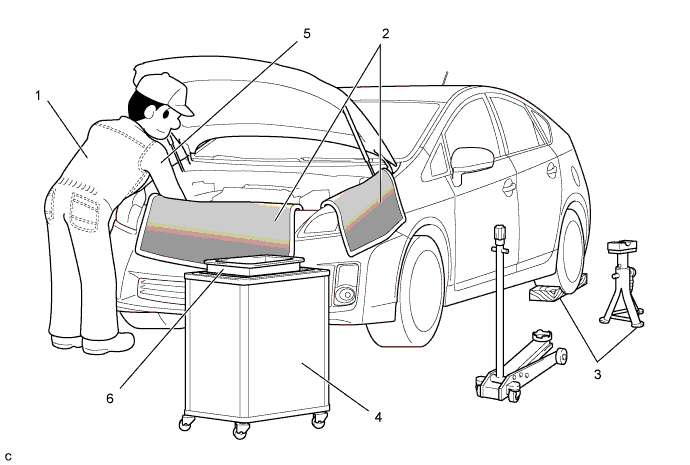
| 1 | Attire |
|
| 2 | Vehicle protection | Prepare a grille cover, fender cover, seat cover and floor mat before starting work. |
| 3 | Safety procedures |
|
| 4 | Preparation of tools and measuring equipment | Before starting work, prepare a tool stand, SST, measuring equipment, oil, and any replacement parts required. |
| 5 | Removal and installation, disassembly and assembly operations |
|
| 6 | Removed parts |
|
JACKING UP AND SUPPORTING VEHICLE
Care must be taken when jacking up and supporting the vehicle. Be sure to lift and support the vehicle at the proper locations.
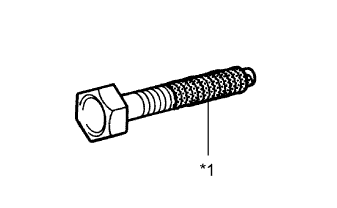 |
PRECOATED PARTS
| *1 | Seal Lock Adhesive |
Precoated parts are bolts and nuts that are coated with seal lock adhesive at the factory.
If a precoated part is retightened, loosened or moved in any way, it must be recoated with the specified adhesive.
When reusing a precoated part, clean off the old adhesive and dry the part with compressed air. Then apply new seal lock adhesive appropriately to that part.
Some seal lock agents harden slowly. You may have to wait for the seal lock adhesive to harden.
GASKETS
When necessary, use a sealer on gaskets to prevent leaks.
BOLTS, NUTS AND SCREWS
Carefully follow all the specifications for tightening torque. Always use a torque wrench.
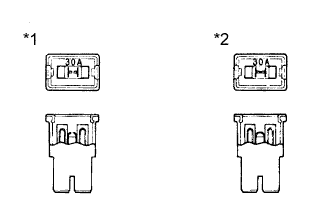 |
FUSES
| *1 | INCORRECT |
| *2 | CORRECT |
When inspecting a fuse, check that the wire of the fuse is not broken.
If the wire of a fuse is broken, confirm that there are no shorts in its circuit.
When a fuse is replaced, a fuse with the same amperage rating must be used.
| Illustration | Symbol | Part Name | Abbreviation |
 |  | FUSE | FUSE |
 |  | MEDIUM CURRENT FUSE | M-FUSE |
 |  | HIGH CURRENT FUSE | H-FUSE |
 |  | FUSIBLE LINK | FL |
 |  | CIRCUIT BREAKER | CB |
CLIPS
The removal and installation methods of typical clips used for vehicle body parts are shown in the table below.
| Shape (Example) | Removal/Installation |
 | 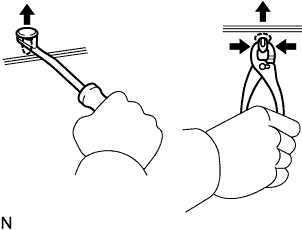 Remove the clips with a clip remover or pliers. |
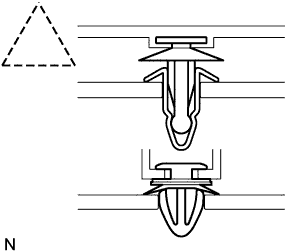 |  Remove the clips with a clip remover or screwdriver. |
 |  Remove the clips with a wide scraper to prevent panel damage. |
 |  Remove the clips by pushing the center pin through and prying out the shell. |
 |  Remove the clips by unscrewing the center pin and prying out the shell. |
 |  Remove the clips by prying out the pin and then prying out the shell. |
CLAWS
The removal and installation methods of typical claws used for vehicle body parts are shown in the table below.
| Shape (Example) | Illustration | Procedure |
 | 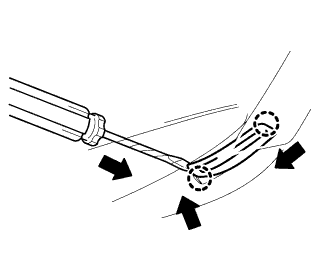 | Using a screwdriver, disengage the claws and remove the cap or cover. |
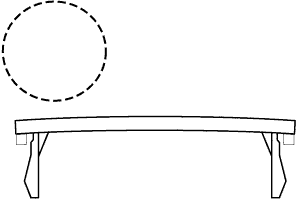 | 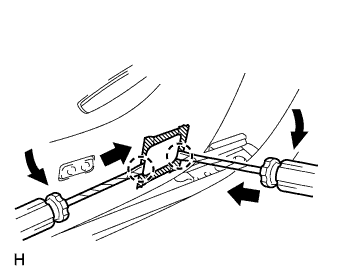 | Using a screwdriver, disengage the claws and remove the cap or cover. |
 | 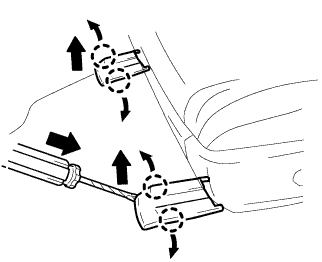 | Using a screwdriver, detach the claws and remove the cap or cover. |
HINGES, GUIDES, CLAMPS, PINS, ETC.
The removal and installation methods of typical hinges, guides, clamps and pins used for vehicle body parts are shown in the table below.
| Shape (Example) | Removal/Installation |
 |  |
 | 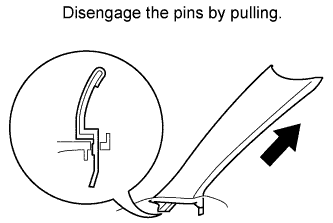 |
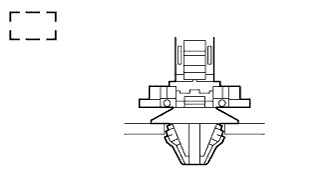 | 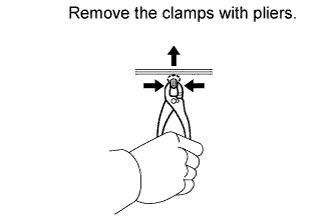 |
 | 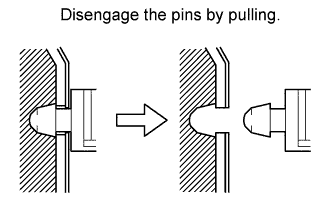 |
REMOVAL AND INSTALLATION OF VACUUM HOSES
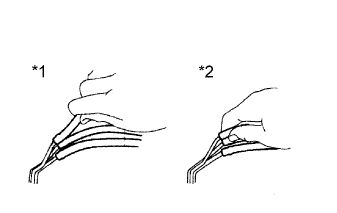 |
To disconnect a vacuum hose, pull and twist it from the end of the hose. Do not pull it from the middle of the hose as this may damage the hose.
| *1 | INCORRECT |
| *2 | CORRECT |
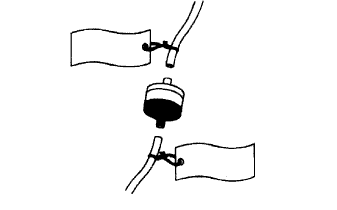 |
When disconnecting vacuum hoses, use tags to identify where they should be reconnected.
After completing any hose related repairs, double-check that the vacuum hoses are properly connected. The label under the hood shows the proper layout.
When using a vacuum gauge, never force the hose onto a connector that is too large. If a hose has been stretched, air may leak. Use a step-down adapter if necessary.
 |
TORQUE WHEN USING TORQUE WRENCH WITH EXTENSION TOOL
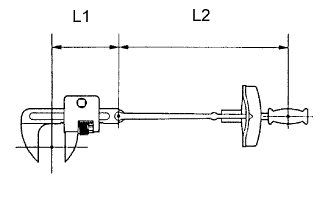 |
Use the formula below to calculate special torque values for situations where SST or an extension tool is combined with a torque wrench.
| T' | Reading of torque wrench {N*m (kgf*cm, ft.*lbf)} |
| T | Torque {N*m (kgf*cm, ft.*lbf)} |
| L1 | Length of SST or extension tool {cm (in.)} |
| L2 | Length of torque wrench {cm (in.)} |
| 2.PRECAUTIONS FOR HIGH-VOLTAGE CIRCUIT INSPECTION AND SERVICE |
Technicians must undergo special training to be able to service and inspect the high-voltage system.
All high-voltage wire harnesses and connectors are colored orange. The HV battery and other high-voltage components have "High Voltage" caution labels. Do not carelessly touch these wires or components.
When there is a problem with the wire harness or connector of a high-voltage circuit, repairs to the harness or connector should not be attempted. Replace damaged or malfunctioning high voltage cables or connectors.
Before inspecting or servicing the high-voltage system, be sure to follow all safety measures, such as wearing insulated gloves and removing the service plug to prevent electrocution. Carry the removed service plug in your pocket to prevent other technicians from accidentally reconnecting it while you are servicing the vehicle.
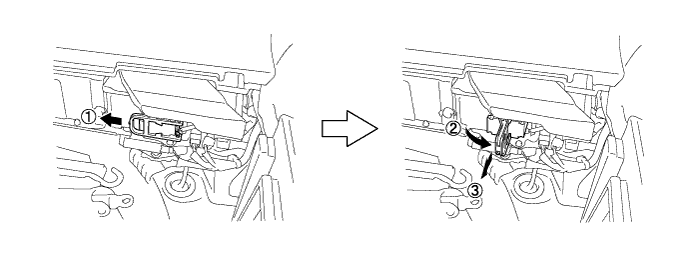
After removing the service plug, wait 10 minutes before touching any of the high-voltage connectors and terminals.
Before using insulated gloves, be sure to check them for cracks, tears and other types of damage by performing the following procedure.

When servicing the vehicle, do not carry metal objects like mechanical pencils or rulers that can be dropped accidentally and cause a short circuit.
Before touching a bare high-voltage terminal, wear insulated gloves and use a tester to make sure that the terminal voltage is 0 V.
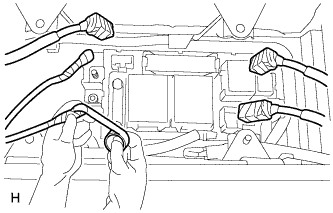 |
After disconnecting or exposing a high-voltage connector or terminal, insulate it immediately using insulating tape.
Bolts and nuts for high-voltage terminals should be tightened firmly to the specified torque. Both insufficient and excessive torque can cause failure.
Use the "CAUTION: HIGH VOLTAGE DO NOT TOUCH" sign to notify other technicians that the high-voltage system is being inspected and/or repaired.
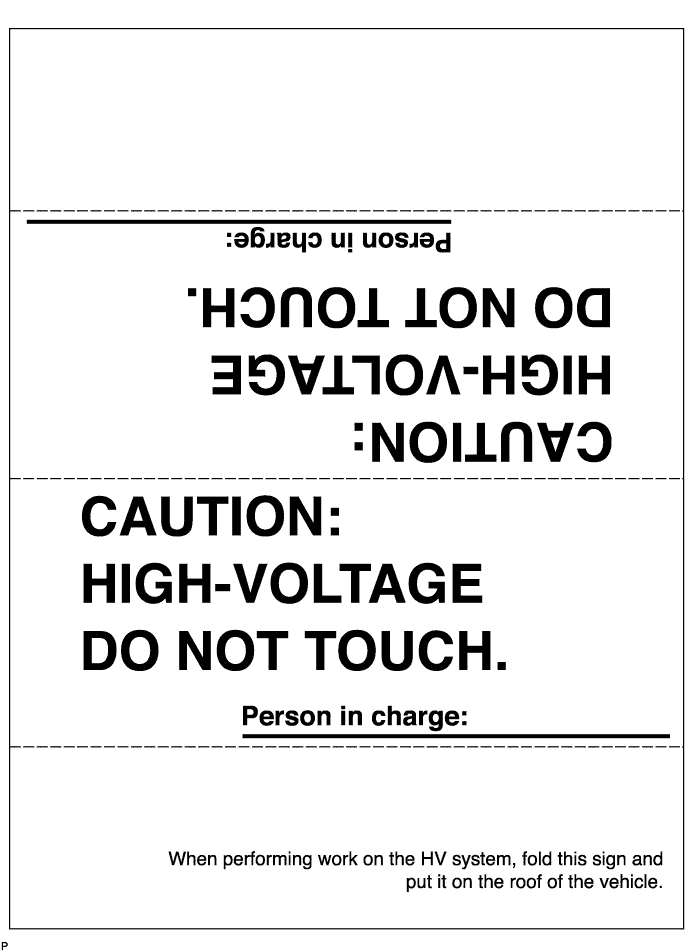
After servicing the high-voltage system and before reinstalling the service plug, check again that you have not left a part or tool inside, that the high-voltage terminals are firmly tightened, and that the connectors are correctly connected.
When installing hybrid system components such as the HV battery, make sure that the polarity of all connections is correct.
| 3.PRECAUTIONS TO BE OBSERVED WHEN INSPECTING OR SERVICING ENGINE COMPARTMENT |
The vehicle automatically turns the engine on and off when the READY light on the instrument panel is illuminated. To avoid injury, make sure that both the indicator on the power switch and the READY light on the meter are off.
| 4.ACTIONS TO BE TAKEN WHEN A WARNING LIGHT IS LIT |

| *1 | READY Light | *2 | Master Warning Light |
| *3 | MIL | *4 | Charge Warning Light |
| *5 | Multi-information Display | - | - |
If one of the warning lights (2) to (4) illuminates, connect the intelligent tester to the DLC3 to check the DTCs (Diagnostic Trouble Codes). Then, refer to the applicable troubleshooting steps in this manual to inspect and repair the affected area. The foregoing actions are also required if the READY light does not illuminate when attempting to turn the power switch on (READY).
| Indicator Light | Vehicle Condition |
| (1) READY (TO DRIVE) | Illuminates when the power switch is turned on (READY), indicating that the vehicle is ready to be driven. |
| (2) Master Warning Light | The master warning light comes on or flashes to indicate that a warning is currently being displayed on the multi-information display. Depending on the warning, the buzzer may also sound. When any malfunction occurs in the hybrid system or hybrid battery system, the master warning light comes on or flashes along with a buzzer, and a warning, "CHECK HYBRID SYSTEM", is displayed on the multi-information display. |
| (3) MIL | Illuminates when there is a malfunction in the engine control system. (Also illuminates when the power switch is turned on.) |
| (4) Charge Warning Light | Illuminates when there is a malfunction in the charging system. (Be sure to check the DTC (Diagnostic Trouble Code) if this light illuminates together with the master warning light.) |
| 5.ACTIONS TO BE TAKEN WHEN BATTERIES ARE DEPLETED |
Perform this procedure when the auxiliary battery is fully depleted.
Engage the parking brake.
Turn the power switch off and remove the key from the interior detection area.
 |
Using booster cables, connect the 12 V battery of the rescue vehicle and the auxiliary battery of the stalled vehicle as shown in the illustration.
| Connecting Sequence | Connecting Location |
| 1 | Positive booster terminal of stalled vehicle |
| 2 | Positive battery terminal of rescue vehicle |
| 3 | Negative battery terminal of rescue vehicle |
| 4 | Position shown in the illustration on stalled vehicle |
Start the engine of the rescue vehicle and run the engine at a speed slightly higher than usual.
Turn the power switch on (READY).
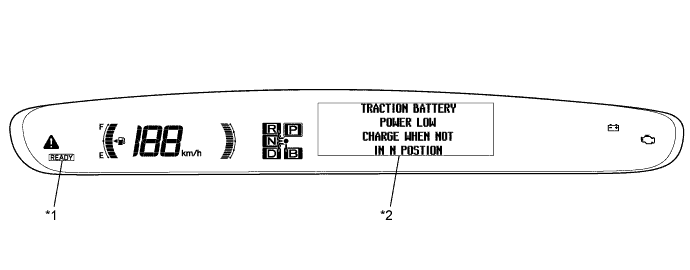
| *1 | Master Warning Light | *2 | Multi-information Display |
When the hybrid vehicle battery is depleted:
Replace the hybrid vehicle battery.
| 6.ACTIONS TO BE TAKEN FOR VEHICLES DAMAGED BY IMPACT |
Items to be prepared for the accident site
Actions to be taken at the accident site
Check the vicinity of the hybrid vehicle battery for any leakage of the electrolyte.
If damage to any of the high-voltage components and cables is suspected, cut the high-voltage circuit using the following procedure.
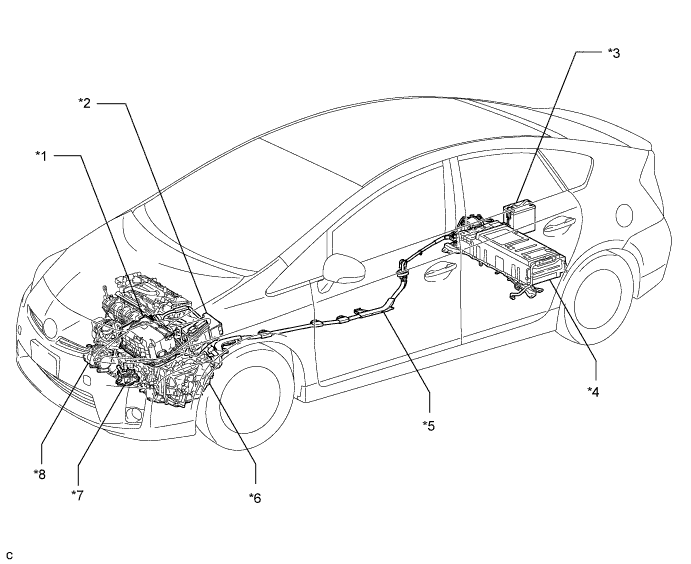
| *1 | Inverter with Converter Assembly | *2 | Engine Room Junction Block Assembly |
| *3 | Auxiliary Battery | *4 | HV Battery Assembly |
| *5 | No. 3 Wire Frame | *6 | Hybrid Vehicle Transaxle Assembly |
| *7 | Water Pump with Motor Assembly | *8 | Compressor with Motor Assembly |
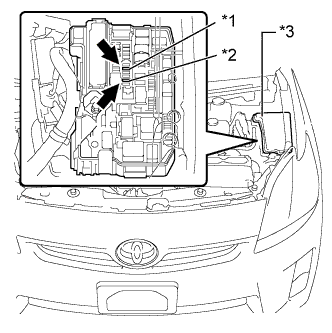 |
Turn the power switch off.
| *1 | AM2 Fuse |
| *2 | IGCT Fuse |
| *3 | Engine Room Junction Block Assembly |
Disconnect the cable from the negative terminal of the auxiliary battery.
Wear insulated gloves, and then remove the service plug.
Moving the damaged vehicle
If any of the following conditions is met, tow the vehicle away using a tow truck.
Park the vehicle in a safe place.
Apply the parking brake, and then push the P position switch.
Turn the power switch off, and disconnect the cable from the negative (-) terminal of the auxiliary battery.
Remove the service plug while wearing insulated gloves.
Actions required after moving the damaged vehicle
Procedure
If you see any liquid on the road surface, it could be highly alkaline electrolyte leakage.
Wear rubber gloves and goggles, neutralize the liquid with saturated boric acid solution, and then apply red litmus paper to the liquid. Check that the paper does not turn blue. Wipe the neutralized liquid with a shop rag or piece of cloth.
Items to be prepared (when repairing a damaged vehicle)
Precautions to be observed when servicing a damaged vehicle
Wear insulated or rubber gloves, goggles, and safety shoes.
Check the HV battery and immediate area for any electrolyte leakage.
Do not touch any bare cables that could be high voltage cables. If a cable must be touched or if accidental contact is possible, follow the following instructions: 1) wear insulated gloves and goggles, 2) measure the voltage between the cable and body ground using an electrical tester, and 3) insulate the cable using insulating tape.
If damage to any of the high-voltage components and cables is suspected, cut the high-voltage circuit using the procedure below.
 |
Turn the power switch off.
| *1 | AM2 Fuse |
| *2 | IGCT Fuse |
| *3 | Engine Room Junction Block Assembly |
Disconnect the cable from the negative terminal of the auxiliary battery.
Wear insulated gloves, and then remove the service plug.
Precautions to be taken when disposing of the vehicle
Disposing of HV battery
When scrapping the vehicle, remove the HV battery from the vehicle and return it to the location specified by the manufacturer. Any damaged HV battery should also be returned to the specified location.
Precautions to be observed when towing
Tow the damaged vehicle with its front and rear wheels lifted off the ground.
Towing with the 4 wheels on the ground
| 7.FOR VEHICLES EQUIPPED WITH SRS AIRBAG AND SEAT BELT PRETENSIONER |
GENERAL NOTICE
As malfunctions of the SRS are difficult to confirm, the Diagnostic Trouble Codes (DTCs) become the most important source of information when troubleshooting. When troubleshooting the SRS, always check for DTCs before disconnecting the battery.
Work must be started at least 90 seconds after the power switch is turned off and after the cable is disconnected from the negative (-) battery terminal.
The SRS is equipped with a back-up power source. If work is started within 90 seconds after turning the power switch off and disconnecting the cable from the negative (-) battery terminal, the SRS may deploy.
When the cable is disconnected from the negative (-) battery terminal, the clock and audio system memory will be cleared. Before starting work, make a note of the settings of each memory system. When work is finished, reset the clock and audio system as before.
If the vehicle has been involved in a minor collision where the SRS does not deploy, the steering pad, front passenger airbag assembly, knee airbag assembly, seat side airbag assembly, curtain shield airbag assembly and seat outer belt assembly should be inspected before further use of the vehicle.
Never use SRS parts from another vehicle. When replacing parts, use new parts.
Before repairs, remove the airbag sensor assemblies if impacts are likely to be applied to the sensor during repairs.
Never disassemble and attempt to repair any airbag sensor assemblies or airbag assemblies.
Replace the airbag sensor assemblies and the airbag assemblies if: 1) damage has occurred from being dropped, or 2) cracks, dents or other defects in the case, bracket or connector are present.
Do not directly expose the airbag sensor assemblies or airbag assemblies to hot air or flames.
Use a voltmeter/ohmmeter with high impedance (minimum = 10 kΩ) for troubleshooting electrical circuits.
Information labels are attached to the SRS components. Follow the instructions on the labels.
After work on the SRS is completed, check the SRS warning light.
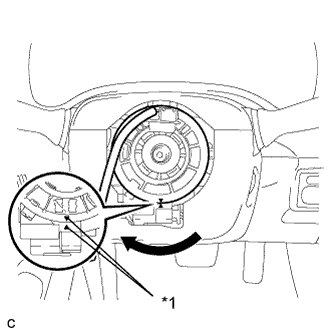 |
SPIRAL CABLE
| *1 | Alignment Mark |
The steering wheel must be fitted correctly to the steering column with the spiral cable at the neutral position. Otherwise, cable damage and other problems may occur. Refer to the information about correct installation of the steering wheel (Click here).
STEERING PAD
Always place a removed or new steering pad with the surface facing upward as shown in the illustration. Placing the steering pad with the pad surface facing downward could cause a serious accident if the airbag deploys. Also, do not place anything on top of the steering pad.

| *1 | CORRECT | *2 | INCORRECT |
Never measure the resistance of the airbag squib. This may cause the airbag to deploy, which could cause serious injury.

Grease or detergents of any kind should not be applied to the steering pad.
Store the steering pad in an area where the ambient temperature is below 93°C (200°F), the humidity is not high and there is no electrical noise.
Before using an electric welder anywhere on the vehicle, disconnect the center airbag sensor assembly connectors. These connectors contain shorting springs. This feature reduces the possibility of the airbag deploying due to current entering the squib wiring.
When disposing of the vehicle or the steering pad by itself, the airbag should be deployed using SST before disposal (Click here). Deploy the airbag in a safe place away from electrical noise.
FRONT PASSENGER AIRBAG ASSEMBLY
Always place a removed or new front passenger airbag assembly with the pad surface facing upward as shown in the illustration. Placing the airbag assembly with the airbag deployment direction facing downward could cause a serious accident if the airbag deploys.

| *1 | CORRECT | *2 | INCORRECT |
Never measure the resistance of the airbag squib. This may cause the airbag to deploy, which could cause serious injury.

Grease or detergents of any kind should not be applied to the front passenger airbag assembly.
Store the airbag assembly in an area where the ambient temperature is below 93°C (200°F), the humidity is not high and there is no electrical noise.
Before using an electric welder anywhere on the vehicle, disconnect the center airbag sensor assembly connectors. These connectors contain shorting springs. This feature reduces the possibility of the airbag deploying due to current entering the squib wiring.
When disposing of the vehicle or the airbag assembly unit by itself, the airbag should be deployed using SST before disposal (Click here). Deploy the airbag in a safe place away from electrical noise.
KNEE AIRBAG ASSEMBLY
Always place a removed or new knee airbag assembly with the airbag deployment direction facing upward as shown in the illustration. Placing the airbag assembly with the airbag deployment direction facing downward could cause a serious accident if the airbag deploys.

| *1 | CORRECT | *2 | INCORRECT |
Never measure the resistance of the airbag squib. This may cause the airbag to deploy, which could cause serious injury.

Grease or detergents of any kind should not be applied to the knee airbag assembly.
Store the knee airbag assembly in an area where the ambient temperature is below 93°C (200°F), the humidity is not high and there is no electrical noise.
Before using an electric welder anywhere on the vehicle, disconnect the center airbag sensor assembly connectors. These connectors contain shorting springs. This feature reduces the possibility of the airbag deploying due to current entering the squib wiring.
When disposing of a vehicle or knee airbag assembly unit by itself, the airbag should be deployed using SST before disposal (Click here). Deploy the airbag in a safe place away from electrical noise.
SEAT SIDE AIRBAG ASSEMBLY
Always place a removed or new seat side airbag assembly with the airbag deployment direction facing upward.
Never measure the resistance of the airbag squib. This may cause the airbag to deploy, which could cause serious injury.

Grease or detergents of any kind should not be applied to the seat side airbag assembly.
Store the airbag assembly in an area where the ambient temperature is below 93°C (200°F), the humidity is not high and there is no electrical noise.
Before using an electric welder anywhere on the vehicle, disconnect the center airbag sensor assembly connectors. These connectors contain shorting springs. This feature reduces the possibility of the airbag deploying due to current entering the squib wiring.
When disposing of a vehicle or the airbag assembly unit by itself, the airbag should be deployed using SST before disposal (Click here). Deploy the airbag in a safe place away from electrical noise.
CURTAIN SHIELD AIRBAG ASSEMBLY
Always place a removed or new curtain shield airbag assembly in a clear plastic bag, and keep it in a safe place.

| *1 | CORRECT | *2 | INCORRECT |
| *3 | Clear Plastic Bag | - | - |
Never measure the resistance of the airbag squib. This may cause the airbag to deploy, which could cause serious injury.

Grease or detergents of any kind should not be applied to the curtain shield airbag assembly.
Store the airbag assembly in an area where the ambient temperature is below 93°C (200°F), the humidity is not high and there is no electrical noise.
Before using an electric welder anywhere on the vehicle, disconnect the center airbag sensor assembly connectors. These connectors contain shorting springs. This feature reduces the possibility of the airbag deploying due to current entering the squib wiring.
When disposing of a vehicle or the airbag assembly unit by itself, the airbag should be deployed using SST before disposal (Click here). Deploy the airbag in a safe place away from electrical noise.
FRONT SEAT OUTER BELT ASSEMBLY (SEAT BELT PRETENSIONER)
Never measure the resistance of the front seat outer belt assembly. This may cause the pretensioner of the front seat outer belt assembly to activate, which could cause serious injury.

Never disassemble the front seat outer belt assembly.
Never install the front seat outer belt assembly on another vehicle.
Store the front seat outer belt assembly in an area where the ambient temperature is below 80°C (176°F), the humidity is not high and there is no electrical noise.
Before using an electric welder anywhere on the vehicle, disconnect the center airbag sensor assembly connectors. These connectors contain shorting springs. This feature reduces the possibility of the airbag deploying due to current entering the squib wiring.
When disposing of a vehicle or the front seat outer belt assembly unit by itself, the front seat outer belt assembly should be activated before disposal (Click here). Activate the front seat outer belt assembly in a safe place away from electrical noise.
As the front seat outer belt assembly is hot after being activated, allow some time for it to cool down sufficiently before disposal. Never apply water to cool down the front seat outer belt assembly.
Grease, detergents, oil or water should not be applied to the front seat outer belt assembly.
CENTER AIRBAG SENSOR ASSEMBLY
Never reuse a center airbag sensor assembly that has been involved in a collision where the SRS has deployed.
The connectors to the center airbag sensor assembly should be connected or disconnected with the sensor installed to the vehicle. If the connectors are connected or disconnected while the center airbag sensor assembly is not installed, the SRS may activate.
Work must be started at least 90 seconds after the power switch is turned off and the cable is disconnected from the negative (-) battery terminal, even if only loosening the bolts of the center airbag sensor assembly.
WIRE HARNESS AND CONNECTOR
All the connectors in the system are a standard yellow color. If an SRS wire harness has an open circuit or a connector is broken, replace it.
| 8.ELECTRONIC CONTROL |
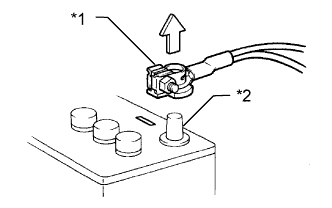 |
| *1 | Cable |
| *2 | Negative (-) Battery Terminal |
DISCONNECTING AND RECONNECTING NEGATIVE BATTERY CABLE
Before performing work on electronic components, disconnect the cable from the negative (-) battery terminal to prevent damage to the electrical system or components.
When disconnecting the cable, turn the power switch and headlight switch off and loosen the cable nut completely. Perform these operations without twisting or prying the cable. Then, disconnect the cable.
Clock settings, radio settings, audio system memory, DTCs and other data will be cleared when the cable is disconnected from the negative (-) battery terminal. Write down any necessary data before disconnecting the cable.
 |
HANDLING OF ELECTRONIC PARTS
| *1 | INCORRECT |
Do not open the cover or case of the ECU unless absolutely necessary. If the IC terminals are touched, the IC may be rendered inoperative by static electricity.
Do not pull on the wires when disconnecting electronic connectors. Pull on the connector itself.
Do not drop electronic components, such as sensors or relays. If they are dropped on a hard surface, they should be replaced.
When cleaning the engine compartment with steam, protect the electronic components, air filter and emission-related components from water.
Never use an impact wrench to remove or install temperature switches or temperature sensors.
When measuring the resistance between terminals of a wire connector, insert the tester probe carefully to prevent the terminals from bending.
| 9.FOR VEHICLES EQUIPPED WITH REMOTE AIR CONDITIONING SYSTEM AND SOLAR VENTILATION SYSTEM |
Vehicles with the remote air conditioning system have the following risks that it is necessary to be aware of when performing repairs. Therefore, make sure to take care of the key (electrical transmitter) carefully so that the remote air conditioning system is not operated unexpectedly.
| The electrical fan and other items in the engine compartment may operate resulting in various hazards. |
| The wipers may operate if the wiper switch is in the on position when the remote air conditioning system is activated. If this occurs, there is the potential for damage to the glass, wipers or injury. |
| When the light control switch is in the tail, head or AUTO position, the headlights may turn on. |
| Short circuits may occur if electrical inspections are being performed when the remote air conditioning system is turned on, because the IG circuit is powered at this time. |
When performing repairs on vehicles with the solar ventilation system, turn the solar ventilation switch off.
| 10.REMOVAL AND INSTALLATION OF FUEL CONTROL PARTS |
PLACE FOR REMOVING AND INSTALLING FUEL SYSTEM PARTS
Work in a location with good air ventilation that does not have welders, grinders, drills, electric motors, stoves, or any other ignition sources nearby.
Never work in a pit or near a pit as fuel vapors will collect there.
REMOVING AND INSTALLING FUEL SYSTEM PARTS
Prepare a fire extinguisher before starting work.
To prevent static electricity, install a ground wire between the fuel changer and vehicle, and do not spray the surrounding area with water. Be careful when performing work in this area, as the floor surface will become slippery. Do not clean up gasoline spills with water, as this may cause the gasoline to spread, and possibly create a fire hazard.
Avoid using electric motors, work lights and other electric equipment that can cause sparks or high temperatures.
Avoid using iron hammers as they may create sparks.
Dispose of fuel-contaminated cloth separately using a fire resistant container.
| 11.REMOVAL AND INSTALLATION OF ENGINE INTAKE PARTS |
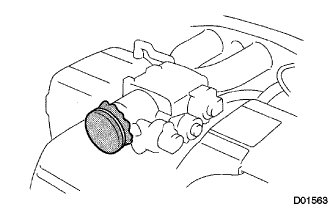 |
If any metal particles enter intake system parts, this may damage the engine.
When removing and installing intake system parts, cover the openings of the removed parts and engine openings. Use adhesive tape or other suitable materials.
When installing intake system parts, check that no metal particles have entered the engine or installed parts.
| 12.HANDLING OF HOSE CLAMPS |
 |
| *1 | Clamp Track |
| *2 | Spring Type Clamp |
Before removing a hose, check the clamp position so that it can be reinstalled in the same position.
Replace any deformed or dented clamps with new ones.
When reusing a hose, attach the clamp on the clamp track portion of the hose.
For a spring type clamp, it may be necessary to spread the tabs slightly after installation by pushing them in the direction of the arrows as shown in the illustration.
| 13.FOR VEHICLES EQUIPPED WITH MOBILE COMMUNICATION SYSTEMS |
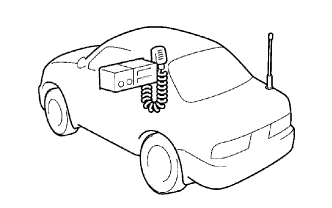 |
Install an antenna as far away from the ECU and sensors of the vehicle electronic systems as possible.
Install an antenna and feeder at least 20 cm (7.87 in.) away from the ECU and sensors of the vehicle electronic systems. For details about ECU and sensor locations, refer to the section on the applicable components.
Keep the antenna and feeder separate from other wiring as much as possible. This will prevent signals sent from the communication equipment from affecting vehicle equipment and vice versa.
Check that the antenna and feeder are correctly adjusted.
Do not install a high-powered mobile communication system.
| 14.HEADLIGHT INSPECTION OR MAINTENANCE |
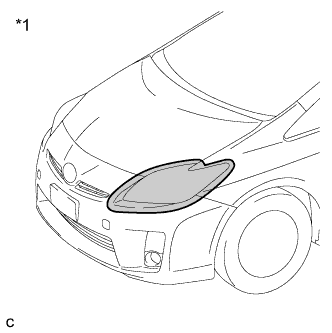 |
When the headlights are illuminated, do not cover the headlights for 3 minutes or more.
| *1 | Illumination for 3 minutes or more prohibited if covered |
| 15.FOR VEHICLES EQUIPPED WITH TRACTION CONTROL (TRC) AND VEHICLE STABILITY CONTROL (VSC) SYSTEMS |
NOTICES FOR WHEN TESTING WITH DRUM TESTER
When testing with a 2-wheel drum tester such as a speedometer tester, a combination speedometer and brake tester, or a chassis dynamometer, perform the following procedure to enter inspection mode and disable the TRC and VSC systems (Click here).
NOTICES FOR VSC RELATED PROCEDURES
For VSC related parts, adjustments are required after removal and installation. Therefore, perform removal and installation only when necessary.
When performing VSC related procedures, be sure to strictly follow the preparation and completion procedures.
When performing removal and installation or replacement of VSC related parts, first disconnect the cable from the negative (-) battery terminal.
| 16.ELECTRONIC SHIFT LEVER SYSTEM |
BASIC OPERATION
This vehicle is equipped with an electronic shift lever system. This system electrically communicates the driver's intended shift state to the ECUs responsible for system control. The system also uses an electrically operated transaxle parking lock mechanism.
This system allows the driver to select the reverse (R), neutral (N), drive (D) and brake (B)* shift states using the shift lever, or select park (P) by pushing the P position switch (transmission shift main switch). Shift states are ECU controlled based on the actions of the driver and various conditions. Shift states can be verified using the shift position indicator in the combination meter or by using the intelligent tester.
| 17.WHEN INSPECTING VEHICLES |
VEHICLE CONDITIONS
Before activating inspection mode, turn the air conditioning off, start the hybrid system with park (P) selected, and check that the engine stops within several seconds after starting (engine warm up check).
Activate the appropriate inspection mode and inspect the vehicle (Click here).
| Test Item | Mode | Shift State |
| 1. Vehicle straight travelling test (side slip inspection) | Maintenance mode or normal mode | D |
| 2. Braking force test | Maintenance mode | N |
| 3. Speedometer test | Maintenance mode | D |
| 4. Exhaust gas test (idling) | Maintenance mode | P |
| 5. Headlight test | Maintenance mode or normal mode | P |
Reset inspection mode immediately after completion of inspection.
WHEN USING A BRAKE TESTER
Place the wheels to be tested (front or rear) onto the rollers.
Start the engine to allow normal brake booster operation.
Move the selector lever to N.
Operate the brakes to perform the test.
WHEN USING A SPEEDOMETER TESTER
Depress the accelerator pedal slowly and gradually accelerate the vehicle. Make a measurement.
After the measurement, use the brakes to gradually decelerate the vehicle.
WHEN USING A CHASSIS DYNAMOMETER
Always set an appropriate load before starting the test.
WHEN USING AN ON-VEHICLE BALANCER
Raise the vehicle until all 4 wheels are off the ground.
Support the vehicle with safety stands at an appropriate height. Make sure that the vehicle does not lean in any direction, and that the tires are completely clear of the floor.
Place the vibration pick-up unit into position for the wheel to be measured*1.
Release the parking brake.
Check that no dragging force exists when turning each wheel by hand.
Put the wheel balancer in position.
Wheel balance measurement should be done by using both the engine and the wheel balancer drive roller to spin the wheels.
| 18.WHEN TOWING VEHICLES |
Use one of the following methods to tow the vehicle.
If the vehicle has trouble with the chassis or drive train, use method 1 (flatbed truck).
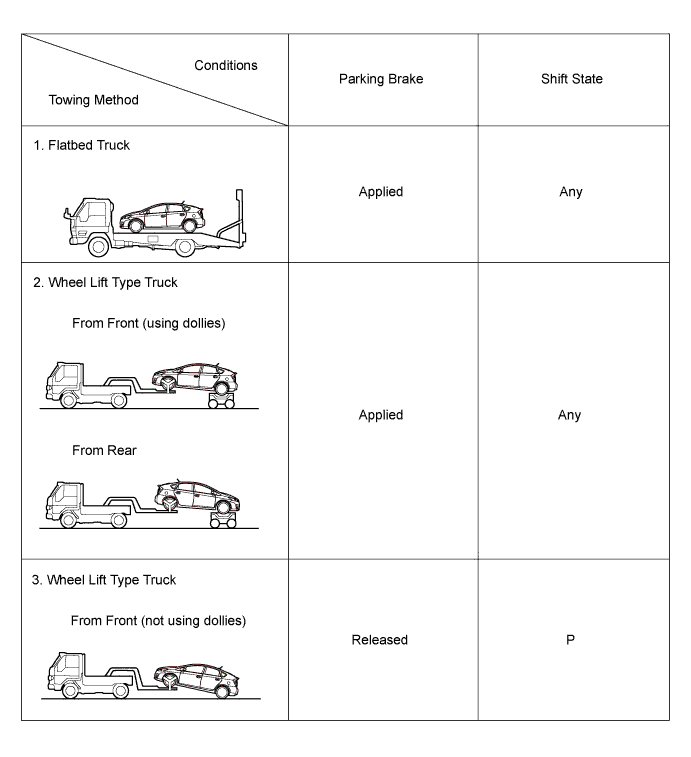
If a tow truck is not available, in an emergency vehicle may be temporarily towed using a cable or chain secured to the emergency towing eyelet(s). This should only be attempted on hard surfaced roads for short distances below 30 km/h (19 mph).
A driver must be in the vehicle to steer and operate the brakes. The vehicle's wheels, drive train, axles, steering and brakes must be in good condition.
Emergency towing procedure
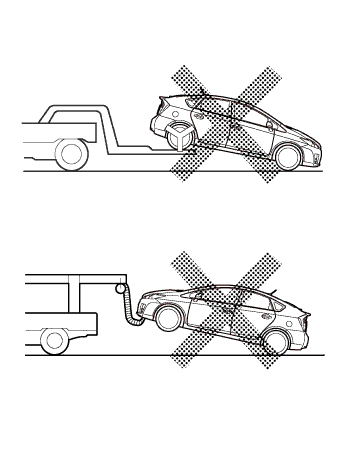 |
The following towing methods shown below are dangerous and can damage the vehicle, so do not use them.
Do not tow the vehicle with only front wheels on the ground.
Do not use a sling-type towing method either from the front or rear.
| 19.FOR VEHICLES EQUIPPED WITH CATALYTIC CONVERTER |
Use only unleaded gasoline.
Avoid performing unnecessary spark tests.
Perform a spark test only when absolutely necessary. Perform this test as rapidly as possible with the injector connector disconnected.
While testing, never race the engine unless instructed.
Do not run the engine when the fuel tank is nearly empty. This may cause the engine to misfire and create an extra load on the converter.